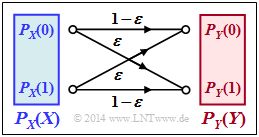Aufgabe 3.10: Transinformation beim BSC
Aus LNTwww
Version vom 3. Februar 2020, 13:41 Uhr von Guenter (Diskussion | Beiträge)
Wir betrachten den Binary Symmetric Channel $\rm (BSC)$. Für die gesamte Aufgabe gelten die Parameterwerte:
- Verfälschungswahrscheinlichkeit: $\varepsilon = 0.1$,
- Wahrscheinlichkeit für $0$: $p_0 = 0.2$,
- Wahrscheinlichkeit für $1$: $p_1 = 0.8$.
Damit lautet die Wahrscheinlichkeitsfunktion der Quelle: $P_X(X)= (0.2 , \ 0.8)$ und für die Quellenentropie gilt:
- $$H(X) = p_0 \cdot {\rm log}_2 \hspace{0.1cm} \frac{1}{p_0} + p_1\cdot {\rm log}_2 \hspace{0.1cm} \frac{1}{p_1} = H_{\rm bin}(0.2)={ 0.7219\,{\rm bit}} \hspace{0.05cm}.$$
In der Aufgabe sollen ermittelt werden:
- die Wahrscheinlichkeitsfunktion der Sinke:
- $$P_Y(Y) = (\hspace{0.05cm}P_Y(0)\hspace{0.05cm}, \ \hspace{0.05cm} P_Y(1)\hspace{0.05cm}) \hspace{0.05cm},$$
- die Verbundwahrscheinlichkeitsfunktion:
- $$P_{XY}(X, Y) = \begin{pmatrix} p_{00} & p_{01}\\ p_{10} & p_{11} \end{pmatrix} \hspace{0.05cm},$$
- die Transinformation:
- $$I(X;Y) = {\rm E} \hspace{-0.08cm}\left [ \hspace{0.02cm}{\rm log}_2 \hspace{0.1cm} \frac{P_{XY}(X, Y)} {P_{X}(X) \cdot P_{Y}(Y) }\right ] \hspace{0.05cm},$$
- die Äquivokation:
- $$H(X \hspace{-0.1cm}\mid \hspace{-0.1cm} Y) = {\rm E} \hspace{0.02cm} \big [ \hspace{0.02cm} {\rm log}_2 \hspace{0.1cm} \frac{1}{P_{\hspace{0.03cm}X \mid \hspace{0.03cm} Y} (X \hspace{-0.05cm}\mid \hspace{-0.05cm} Y)} \big ] \hspace{0.05cm},$$
- die Irrelevanz:
- $$H(Y \hspace{-0.1cm}\mid \hspace{-0.1cm} X) = {\rm E} \hspace{0.02cm} \big [ \hspace{0.02cm} {\rm log}_2 \hspace{0.1cm} \frac{1}{P_{\hspace{0.03cm}Y \mid \hspace{0.03cm} X} (Y \hspace{-0.05cm}\mid \hspace{-0.05cm} X)} \big ] \hspace{0.05cm}.$$
Hinweise:
- Die Aufgabe gehört zum Kapitel Anwendung auf die Digitalsignalübertragung.
- Bezug genommen wird insbesondere auf die Seite Transinformationsberechnung für den Binärkanal.
- In der Aufgabe 3.10Z wird die Kanalkapazität $C_{\rm BSC }$ des BSC–Modells berechnet.
- Diese ergibt sich als die maximale Transinformation $I(X;\ Y)$ durch Maximierung bezüglich der Wahrscheinlichkeiten $p_0$ bzw. $p_1 = 1 - p_0$.
Fragebogen
Musterlösung
(1) Für die gesuchten Größen gilt allgemein bzw. mit den Zahlenwerten $p_0 = 0.2$ und $\varepsilon = 0.1$:
- $$P_{XY}(0, 0) = p_0 \cdot (1 - \varepsilon) \hspace{0.15cm} \underline {=0.18} \hspace{0.05cm}, \hspace{0.5cm} P_{XY}(0, 1) = p_0 \cdot \varepsilon \hspace{0.15cm} \underline {=0.02} \hspace{0.05cm},$$
- $$P_{XY}(1, 0) = p_1 \cdot \varepsilon \hspace{0.15cm} \underline {=0.08} \hspace{0.05cm}, \hspace{1.55cm} P_{XY}(1, 1) = p_1 \cdot (1 - \varepsilon) \hspace{0.15cm} \underline {=0.72} \hspace{0.05cm}.$$
(2) Allgemein gilt:
- $$P_Y(Y) = \big [ {\rm Pr}( Y = 0)\hspace{0.05cm}, {\rm Pr}( Y = 1) \big ] = \big ( p_0\hspace{0.05cm}, p_1 \big ) \cdot \begin{pmatrix} 1 - \varepsilon & \varepsilon\\ \varepsilon & 1 - \varepsilon \end{pmatrix}.$$
Daraus ergeben sich folgende Zahlenwerte:
- $$ {\rm Pr}( Y = 0)= p_0 \cdot (1 - \varepsilon) + p_1 \cdot \varepsilon = 0.2 \cdot 0.9 + 0.8 \cdot 0.1 \hspace{0.15cm} \underline {=0.26} \hspace{0.05cm},$$
- $${\rm Pr}( Y = 1)= p_0 \cdot \varepsilon + p_1 \cdot (1 - \varepsilon) = 0.2 \cdot 0.1 + 0.8 \cdot 0.9 \hspace{0.15cm} \underline {=0.74} \hspace{0.05cm}.$$
(3) Für die Transinformation gilt gemäß der Definition mit $p_0 = 0.2$, $p_1 = 0.8$ und $\varepsilon = 0.1$:
- $$I(X;Y) = {\rm E} \hspace{-0.08cm}\left [ \hspace{0.02cm}{\rm log}_2 \hspace{0.08cm} \frac{P_{XY}(X, Y)} {P_{X}(X) \hspace{-0.05cm}\cdot \hspace{-0.05cm} P_{Y}(Y) }\right ] \hspace{0.3cm} \Rightarrow$$
- $$I(X;Y) = 0.18 \cdot {\rm log}_2 \hspace{0.1cm} \frac{0.18}{0.2 \hspace{-0.05cm}\cdot \hspace{-0.05cm} 0.26} + 0.02 \cdot {\rm log}_2 \hspace{0.08cm} \frac{0.02}{0.2 \hspace{-0.05cm}\cdot \hspace{-0.05cm} 0.74} + 0.08 \cdot {\rm log}_2 \hspace{0.08cm} \frac{0.08}{0.8 \hspace{-0.05cm}\cdot \hspace{-0.05cm} 0.26} + 0.72 \cdot {\rm log}_2 \hspace{0.08cm} \frac{0.72}{0.8 \hspace{-0.05cm}\cdot \hspace{-0.05cm} 0.74} \hspace{0.15cm} \underline {=0.3578\,{\rm bit}} \hspace{0.05cm}.$$
(4) Mit der angegebenen Quellenentropie $H(X)$ erhält man für die Äquivokation:
- $$H(X \hspace{-0.1cm}\mid \hspace{-0.1cm} Y) = H(X) - I(X;Y) = 0.7219 - 0.3578 \hspace{0.15cm} \underline {=0.3642\,{\rm bit}} \hspace{0.05cm}.$$
- Man könnte aber auch die allgemeine Definition mit den Rückschlusswahrscheinlichkeiten $P_{X|Y}(⋅)$ anwenden:
- $$H(X \hspace{-0.1cm}\mid \hspace{-0.1cm} Y) = {\rm E} \hspace{0.02cm} \left [ \hspace{0.05cm} {\rm log}_2 \hspace{0.1cm} \frac{1}{P_{\hspace{0.03cm}X \mid \hspace{0.03cm} Y} (X \hspace{-0.05cm}\mid \hspace{-0.05cm} Y)} \hspace{0.05cm}\right ] = {\rm E} \hspace{0.02cm} \left [ \hspace{0.05cm} {\rm log}_2 \hspace{0.1cm} \frac{P_Y(Y)}{P_{XY} (X, Y)} \hspace{0.05cm} \right ] \hspace{0.05cm}$$
- Im Beispiel erhält man auch nach dieser Berechnungsvorschrift das gleiche Ergebnis $H(X|Y) = 0.3642 \ \rm bit$:
- $$H(X \hspace{-0.1cm}\mid \hspace{-0.1cm} Y) = 0.18 \cdot {\rm log}_2 \hspace{0.1cm} \frac{0.26}{0.18} + 0.02 \cdot {\rm log}_2 \hspace{0.1cm} \frac{0.74}{0.02} + 0.08 \cdot {\rm log}_2 \hspace{0.1cm} \frac{0.26}{0.08} + 0.72 \cdot {\rm log}_2 \hspace{0.1cm} \frac{0.74}{0.72} \hspace{0.05cm}.$$
(5) Richtig ist der Lösungsvorschlag 2:
- Bei gestörter Übertragung $(ε > 0)$ ist die Unsicherheit hinsichtlich der Sinke stets größer als die Unsicherheit bezüglich der Quelle. Man erhält hier als Zahlenwert:
- $$H(Y) = H_{\rm bin}(0.26)={ 0.8268\,{\rm bit}} \hspace{0.05cm}.$$
- Bei fehlerfreier Übertragung $(ε = 0)$ würde dagegen $P_Y(⋅) = P_X(⋅)$ und $H(Y) = H(X)$ gelten.
(6) Auch hier ist der zweite Lösungsvorschlag richtig:
- Wegen $I(X;Y) = H(X) - H(X \hspace{-0.1cm}\mid \hspace{-0.1cm} Y) = H(Y) - H(Y \hspace{-0.1cm}\mid \hspace{-0.1cm} X)$ ist $H(Y|X)$ um den gleichen Betrag größer als $H(X|Y)$, um den $H(Y)$ größer ist als $H(X)$:
- $$H(Y \hspace{-0.1cm}\mid \hspace{-0.1cm} X) = H(Y) -I(X;Y) = 0.8268 - 0.3578 ={ 0.4690\,{\rm bit}} \hspace{0.05cm}$$
- Bei direkter Berechnung erhält man das gleiche Ergebnis $H(Y|X) = 0.4690\ \rm bit$:
- $$H(Y \hspace{-0.1cm}\mid \hspace{-0.1cm} X) = {\rm E} \hspace{0.02cm} \left [ \hspace{0.02cm} {\rm log}_2 \hspace{0.1cm} \frac{1}{P_{\hspace{0.03cm}Y \mid \hspace{0.03cm} X} (Y \hspace{-0.05cm}\mid \hspace{-0.05cm} X)} \right ] = 0.18 \cdot {\rm log}_2 \hspace{0.1cm} \frac{1}{0.9} + 0.02 \cdot {\rm log}_2 \hspace{0.1cm} \frac{1}{0.1} + 0.08 \cdot {\rm log}_2 \hspace{0.1cm} \frac{1}{0.1} + 0.72 \cdot {\rm log}_2 \hspace{0.1cm} \frac{1}{0.9} \hspace{0.05cm}.$$
